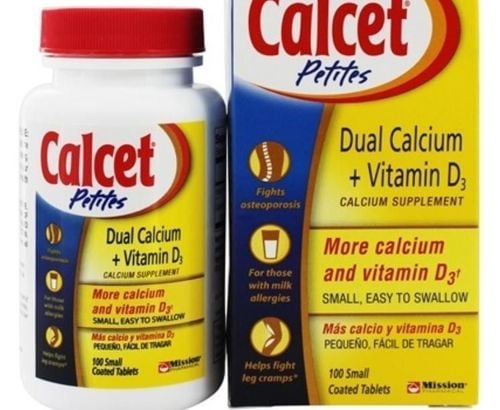This is an automatically translated article.
Philbone A is preferred for use in cases of osteomalacia, rickets or renal osteodystrophy... To ensure the effective use of Philbone A, users need to follow the instructions of the doctor, co Please refer to the following article about the use of Philbone A for more information.
1. What are the uses of Philbone A?
1.1. What is Philbone A? Philbone A belongs to the group of drugs affecting bone metabolism, with registration number VD-24026-15, manufactured by Phil Inter Pharma Co., Ltd. - Korea.
Philbone A drug includes ingredients
Main active ingredient: Calcitriol content of 0.25 mcg. Excipients: Ethanol absolute, butylate hydroxy toluene, butylate hydroxy anisosol, medium chain triglycerides, gelatin, concentrated glycerin, purified water, Sunset yellow FCF, D-sorbitol 70%, Quinolin, Allura red AC, titanium dioxide. The drug is prepared in the form of soft capsules, blisters of 10 tablets, boxes of 5 blisters. Philbone A is recommended for use in children 3 years of age and older and adults. 1.2. What does Philbone A do? Calcitriol facilitates intestinal absorption of calcium and regulates bone mineralization. Calcitriol plays a key role in the regulation of calcium homeostasis and stimulates bone formation. This is a pharmacological basis for the therapeutic effect of osteoporosis.
Philbone-A is prescribed by a doctor only to:
Treat osteoporosis. Rickets, osteomalacia (vitamin D-dependent rickets or hypophosphataemic rickets resistant to vitamin D). Chronic renal failure, especially renal osteodystrophy. Hypoparathyroidism (postoperative, spontaneous or pseudohypoparathyroidism). Contraindications:
Patients with a history and allergy to the main active ingredient Calcitriol or any of the excipients of the drug Philbone A. All diseases related to hypercalcemia. The patient showed signs of vitamin D toxicity.
2. Philbone A . Usage
2.1. How to use Philbone A Philbone A pill for oral use When taking Philbone A, the patient should not chew the tablet, must take the whole tablet with boiled water to cool. 2.2. Dosage of Philbone A The optimal one-day dose of Philbone A should be carefully adjusted for each patient according to blood calcium levels.
In renal osteodystrophy:
At the beginning of treatment, the dose for 1 day is 1 capsule (0.25mcg). After that, taking 1 capsule (0.25mcg) per day is enough. If the response to the drug is shown in the biochemical test values and the clinical symptoms do not improve significantly, the dose can be increased by 1 capsule (0.25 mcg)/day at intervals of 2-4 weeks. During this time, blood calcium should be measured at least twice a week. According to research, doses ranging from 2 tablets (0.5mcg)/day to 4 tablets (1mcg)/day are effective in most patients. In patients with normal or slightly decreased serum calcium levels, a dose of 0.25 mcg (1 capsule) every other day is sufficient. If within 2 - 4 weeks, the response to the drug as shown in the biochemical parameters and the clinical course does not reach the desired level, then every 2 - 4 weeks, the dose can be increased by 0.25 mcg (1 tablets)/day. During this time, blood calcium should be measured at least twice a week. Most patients respond well to doses of 0.5 mcg (2 tablets) to 1 mcg (4 tablets)/day. If barbiturates or antiepileptic drugs are used concurrently with Philbone A, a higher dose of the drug may be required. The effectiveness of treatment depends in part on whether the daily calcium intake is adequate (in adults, about 800-1000 mcg/day). If necessary, increase calcium intake by dietary changes or calcium supplements. In osteoporosis:
The recommended dose is 0.25mcg (1 tablet) twice daily. In the event that the desired response is not achieved, the dose may be increased every other month to a maximum of 2 tablets (0.5 mcg) twice daily. During the dosing phase of the patient, serum calcium should be checked at least twice weekly and if hypercalcaemia occurs, the drug should be discontinued until serum calcium levels return to normal. often. Calcium supplementation is hardly necessary because calcium absorption is increased in postmenopausal patients receiving calcitriol. In cases of hypothyroidism, rickets and osteomalacia:
The recommended starting dose is 1 capsule (0.25mcg)/day, taken every morning. If the response to the drug is shown in biochemical test values and the clinical symptoms are not significantly improved, the dose can be increased by 1 capsule (0.25 mcg)/day every 2 to 4 weeks. During the dosing phase of the patient, serum calcium levels should be checked at least twice weekly. Higher doses may be needed because in patients with hypothyroidism, calcium absorption is sometimes very low. General issues:
After determining the optimal dose of Philbone A for the patient, the blood calcium level must be checked once a month. When serum calcium levels rise above normal by 1mg/100ml (with a mean of 9-11mg/100ml), the dose should be reduced immediately or the drug should be stopped immediately until the test shows again. serum calcium levels returned to normal. Another effective way to bring calcium levels back to normal quickly is to stop other sources of calcium in the body. The researchers have also recommended carefully considering reducing the calcium intake from the daily diet. When patients experience hypercalcemia, calcium and phosphate levels should be checked daily. When serum calcium levels return to normal, the drug can be resumed at a reduced dose as directed by your doctor. Treatment for missed doses:
If you miss a dose of Philbone A, take it as soon as you remember. However, if it is almost time for your next dose, skip the missed dose and take your next dose at the scheduled time. Note that a double dose of Philbone A should not be taken.
Treatment of overdose:
Calcitriol is a metabolite of vitamin D, all cases of Philbone-A overdose will give the same clinical symptoms as for vitamin D overdose. If concomitantly taken orally High levels of calcium and phosphate with Philbone-A can also cause similar symptoms. High calcium levels in the dialysate reflect hypercalcemia. Measures to treat overdose due to accidental ingestion include: Immediate gastric lavage or induce vomiting to avoid absorption of the drug into the bloodstream. Use paraffin oil to increase drug elimination in the feces. Perform multiple blood calcium tests. If serum calcium remains elevated, phosphate and corticosteroids can be administered, and appropriate measures to increase diuresis are used.
3. Notes when using Philbone A
Caution and should consult a doctor if you want to use Philbone A for women who are pregnant or breastfeeding, the patient is a child under 3 years old. Use caution when using Philbone A for patients with kidney stones or coronary artery disease, drivers or operators of dangerous machinery. During the use of Philbone A, the patient absolutely adheres to the dosage instructions of the treating doctor, avoiding increasing or decreasing the dose to speed up the treatment time. Before discontinuing the use of Philbone A, patients should consult their treating physician. Note:
If Philbone A appears strange signs such as discoloration, deformation, watery, the patient should not use it anymore. Philbone A should be stored in a dry place with moderate humidity and away from direct sunlight. Keep Philbone A away from children's play areas, to avoid the possibility that children may ingest the medicine without knowing it.
4. Philbone A . side effects
Philbone A side effects and adverse reactions are similar to those of vitamin D overdose: Hypercalcemia and calcium toxicity. Sometimes acute symptoms such as loss of appetite, headache, vomiting and constipation appear. The following chronic symptoms may occur: malnutrition, sensory disturbances, fever with thirst, polyuria, dehydration, apathy, growth retardation, urinary tract infection. In cases where hypercalcaemia and hyperphosphataemia occur concurrently, soft tissue calcification may occur and can be definitively diagnosed by radiographic imaging. Serum creatinine may be elevated in patients with normal renal function with persistent hypercalcemia. Hypersensitivity reactions to the drug may occur in susceptible individuals
5. Philbone A . drug interactions
The combination of calcitriol with Vitamin D and vitamin D derivatives should be avoided because it can lead to hypercalcemia. The risk of hypercalcaemia may be increased if the drug is used concomitantly with thiazide compounds (diuretics). Patients receiving digitalis-containing drugs should be cautious when determining the dose of Calcitriol because hypercalcemia may accelerate the development of arrhythmias. Because enzyme inducers such as Phenytoin and Phenobarbital increase the metabolism of calcitriol, the dose of calcitriol should be increased when co-administered with these drugs. Cholestyramine reduces absorption of fat-soluble vitamins, so it may decrease absorption of this medicine.
6. How to store Philbone A
The shelf life of Philbone A is 36 months from the date of manufacture. Store in a cool dry place, the temperature does not exceed 15 - 30°C, in the original packaging and protect from light, avoid acidic environment. Keep out of reach of CHILDREN. Above is all information about the drug Philbone A, patients need to carefully read the instructions for use, consult a doctor / pharmacist before using. Absolutely do not arbitrarily buy Philbone A treatment at home because there may be unwanted side effects.
Please dial HOTLINE for more information or register for an appointment HERE. Download MyVinmec app to make appointments faster and to manage your bookings easily.













